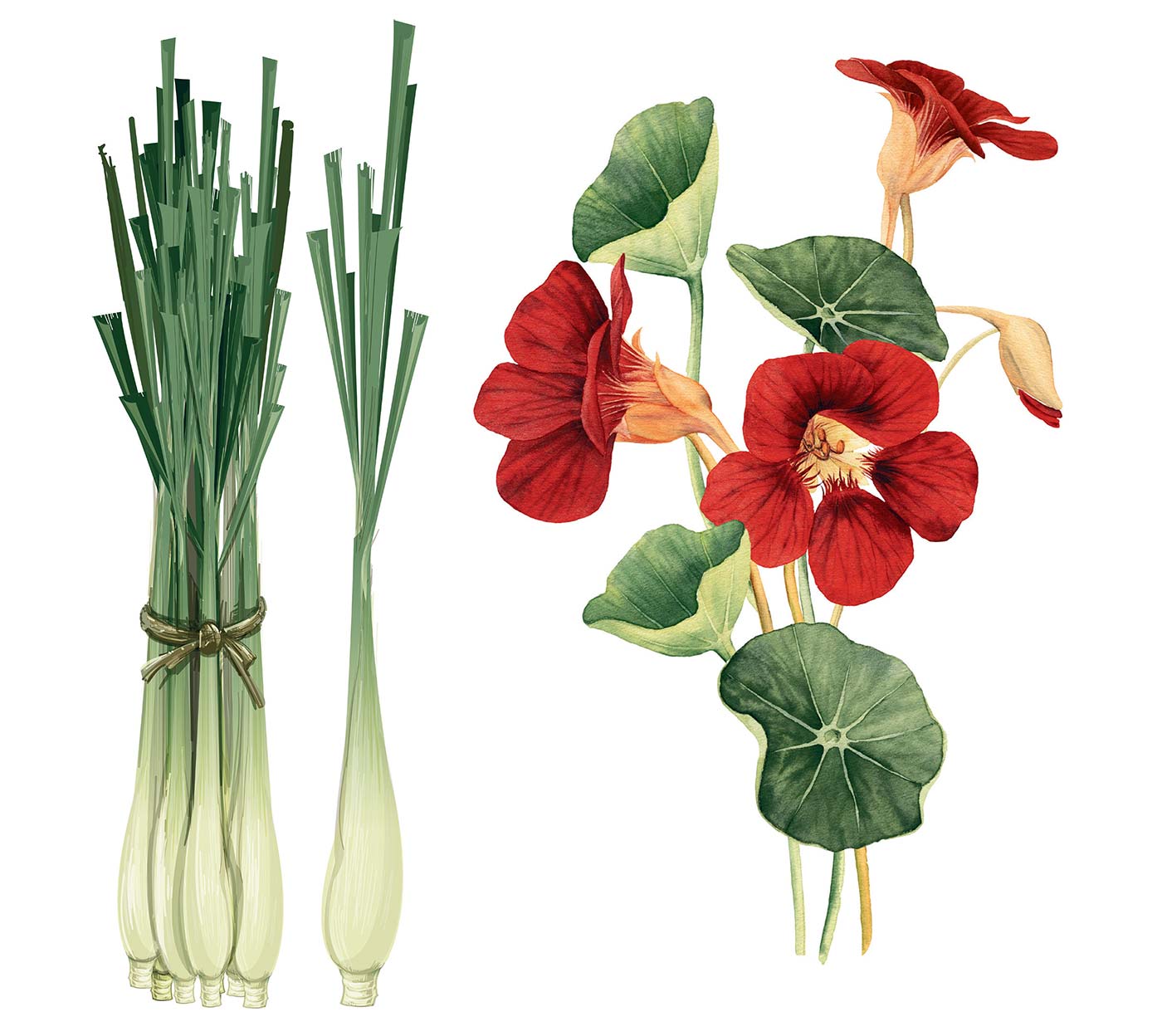Garden Allure: The many benefits of lemongrass and nasturtium
LEMONGRASS
When I breathe in the scent of lemongrass, my mood instantly lifts. This aromatic herb, native to regions in Asia and Australia, has been used by cooks and healers for centuries.
Lemongrass is as it sounds: a grass. Unassuming until you brush past it and a bright lemony-sweet scent rises up that is known to help repel mosquitos and ticks. With other names such as Malabar grass, Cochin grass and fever grass, in some circles this herb is known as the queen of aromatics.
If you don’t happen to reside in a hot or tropical climate, lemongrass can be grown in pots outdoors during the summer and brought into the house, if you have enough light, to overwinter. I often see lemongrass starts at our local farmers markets in the spring and it is becoming more common at local nurseries.
You might have experienced lemongrass in your favorite Thai dish, adding a strong aroma, brightening the fl avor and giving the meal depth and character. The aroma alone is enough reason to bring it into your garden and kitchen, but it has an amazing medicinal purpose as well.
Its diuretic properties make it a great herb to reach for when you want to reduce water weight or gently detox.
Including lemongrass in your diet on a regular basis reportedly helps support healthy blood pressure levels and addresses infl ammation, especially around arthritic conditions and painful joints. A cup of lemongrass tea can help you get through a cold, reduce a fever by accelerating sweating and even help fi ght bacterial and fungal infections.
I love the ancient practice of saving the fresh lemongrass leaves in bunches of tied knots to freeze. When I’m ready to make a soup or use the lemongrass for tea, these knotted bunches come in very handy and last for up to a year in the freezer. When you grow your own, you can stock your own cabinet by chopping the leaves and drying to use throughout the year.
You can steep the top green leaves of lemongrass steep for tea or in a broth, as they are too tough to eat. The lower white part of the leaf can be diced and used in sauces or directly in dishes to consume. The fragrant tea can be used in a variety of ways, including desserts like Strawberry Lemongrass Ginger popsicles.
NASTURTIUM
Nasturtium has been used by gardeners for years to repel aphids and other pests. I can say I’ve had nasturtium planted in my gardens and still had to deal with aphids, but I digress.
This gorgeous flower offers so much more. Its beauty alone adds value to the garden. Pollinators love the red, orange and yellow hues of the nasturtium flower. Its leaves resemble the round nature of a lily pad, yet delicate.
Some varieties creep and vine up or over a trellis.
When we give tours at Wild Moon, I love offering up nasturtium leaves as an edible snack because their peppery flavor often comes as a surprise for folks. The flowers are a bit milder in flavor, while the seeds are even spicier than the leaves. Leaves and flowers can be added to salads, bringing a fun spicy flavor and summery color.
The deep displays of reds, yellows and oranges of the flowers, as well as the strong flavor, are signals that medicine hides inside this garden beauty. Nasturtium is known for helping reduce inflammation in the body.
Along with aiding inflammatory conditions, both the leaves and flowers can support you during cold or flu, specifically helping to expel excess mucus. This could be a possible helper for those summer pollen allergies.
As a tea, nasturtium can also offer relief for those experiencing a urinary tract infection. Perhaps my favorite way to enjoy this herb is simply by adding its leaves and flowers to our summer meals. The flowers will transform any dish to a celebration of summer.
WILD MOON ACRES
Do you have a desire to connect to your local community, to local food and plant medicine or have a desire to learn how to start an organic garden?
Wild Moon Acres is a small urban farm 15 minutes from downtown Indianapolis, started by chef and herbalist, Audrey Barron and husband Sam. Established in 2016 and using permaculture and regenerative growing practices to grow fruit trees, elderberry bushes, mushrooms and medicinal herbs.
Offering a variety of programs and workshops centered around herbalism, homesteading, permaculture and more with a mission to provide products and education that support customers in their quest to thrive and live their most vibrant lives.
Wild Moon Acres is open for school field trips and tours. Find out more at WildMoonAcres.love Follow on Instagram @wild.moon.acres





